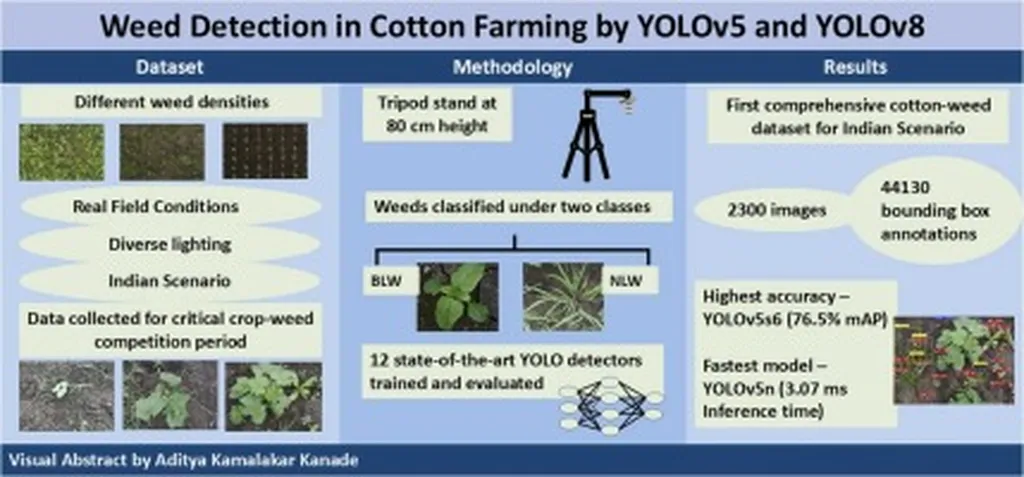In the ever-evolving landscape of precision agriculture, a groundbreaking development has emerged from the School of Software at Jiangxi Agricultural University in Nanchang, China. Researchers, led by Jing Hua, have introduced the HDMS-YOLO model, a novel approach to weed detection that promises to revolutionize farm management and intelligent agricultural systems. Published in the esteemed journal *Frontiers in Plant Science* (translated to English as “Plant Science Frontiers”), this research addresses one of the most persistent challenges in modern farming: accurate weed identification.
The diversity and varying sizes of weeds, coupled with their visual similarity to crops, have long posed significant obstacles to automatic weed removal. Traditional methods often fall short, leading to inefficiencies and increased labor costs. Enter HDMS-YOLO, a model designed to overcome these hurdles through advanced feature extraction and dynamic task alignment.
At the heart of the HDMS-YOLO model are two innovative feature extraction modules: the Shallow and Deep Receptive Field Distillation (SRFD and DRFD) modules. These modules work in tandem to capture both shallow and deep weed features, providing a comprehensive understanding of the farmland environment. The traditional C3K2 structure is replaced by the Partial Convolution-based Multi-Scale Feature Aggregation (PC-MSFA) module, which enhances feature representation through partial convolution and residual connections. This enhancement is crucial for distinguishing between weeds and crops, even in complex farmland environments.
One of the most compelling aspects of the HDMS-YOLO model is its dynamic task-alignment detection head, known as IntegraDet. This component significantly improves localization and classification accuracy, ensuring that weeds are identified with precision. “The IntegraDet head is a game-changer,” says Jing Hua. “It dynamically aligns tasks to improve detection accuracy, making it a vital tool for precision agriculture.”
The results speak for themselves. HDMS-YOLO achieves an impressive accuracy of 74.2%, a recall of 66.3%, and an mAP (mean Average Precision) of 71.2%. These metrics are 2.6%, 2.1%, and 2.6% higher, respectively, than those of YOLO11, a widely used algorithm in the field. Compared to other mainstream algorithms, HDMS-YOLO demonstrates superior overall detection performance, setting a new benchmark for weed identification.
The implications of this research are far-reaching. Accurate weed detection is a cornerstone of precision agriculture, enabling farmers to optimize resource use and reduce environmental impact. By automating weed removal, farmers can significantly cut labor costs and improve crop yields. “This technology has the potential to transform the way we manage farms,” Hua explains. “It’s not just about detecting weeds; it’s about creating more sustainable and efficient agricultural practices.”
The commercial impact of HDMS-YOLO extends beyond individual farms. As the demand for intelligent agricultural systems grows, so does the need for robust and accurate detection models. Companies developing autonomous farming equipment and precision agriculture tools stand to benefit greatly from this technology. The integration of HDMS-YOLO into these systems could lead to more efficient and cost-effective solutions, driving innovation in the agricultural sector.
Looking ahead, the success of HDMS-YOLO paves the way for further advancements in weed detection and precision agriculture. As researchers continue to refine and enhance the model, its applications are likely to expand, offering new opportunities for farmers and agricultural technology companies alike. The journey towards smarter, more sustainable farming practices has taken a significant step forward, thanks to the pioneering work of Jing Hua and the team at Jiangxi Agricultural University.
In the rapidly evolving world of agritech, the HDMS-YOLO model stands as a testament to the power of innovation and the potential of deep learning to transform traditional industries. As we look to the future, one thing is clear: the fusion of technology and agriculture is not just a trend; it’s a revolution.

